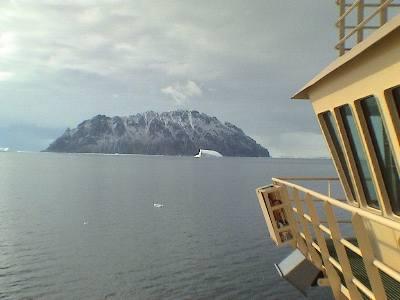19 January, 2004
The ship left port with volunteer help from McMurdo at 12:30. A small
group of McMurdo residents had come to the dock to bid us farewell.
It took some time to maneuver away from the ice dock and to move out
into the channel. Calm winds for the past 24 hours had allowed the
sea ice to reform. As we left dock, the ship broke through clear sea
ice laced with filamentous feathers of white crystals.
The crew and marine techs continued to stow cargo and secure gear as
we headed out to our first area to be mapped pausing occasionally to
take a photo. Everyone got into the act including Captain Mike who
has been aboard ships in the Antarctic for more than ten years. We
passed two ships on our way out, the Coast Guard Ice Breaker, Polar
Sea, as it made its way back into dock at McMurdo, and cargo ship
frozen in the ice along the channel waiting to enter the dock with
the help of the icebreaker. The cargo ship's gangway was down on the
ice and a well-worn footpath was visible from its end across the sea
ice.
The fun was short lived. All hands were called to the 03 conference
room for an information and safety briefing. Ashley Lowe, the MPC
(Marine Projects Coordinator) introduced the marine technicians and
technology support staff aboard the ship. Following these
introductions and the introductions of the members of the science
team, we began our briefing on ship safety. The ships engineer made
it clear that those who survive accidents at sea are the ones who are
prepared. Each of us practiced putting on our flotation suits made
of stretch neoprene. We all waddled out onto the deck and into the
lifeboats in our "lobster suits" in our first emergency practice
drill of the cruise. We were all encouraged to learn the most direct
routes to the gathering areas and lifeboats by the end of the day.
We were then directed to the computer lab for an overview of the
network system with the IT staff. The ships network is divided into
two main areas. One is called the hotel network and is primarily set
up to handle email, and office applications. The science network is
connected to all of the data acquisition equipment aboard the ship
and is designed to store the data for future analysis using a variety
of programs available to the scientists. Email is sent using a
satellite data connection and is delivered 2 or 3 times a day. Email
attachments are limited due to the cost associated with the satellite
connection, but test messages are not a problem.
We were just four hours out of McMurdo and it was nearly time to
start collecting our first data, but we needed to be trained in a for
Marine Mammal Observing and ping editing. The scientists and marine
support staff are very conscientious that the science that is being
conducted aboard ship may have the potential to disturb wildlife.
The marine mammals that we are likely to encounter are whales,
dolphins, and seals. To insure that there is minimal impact on the
marine mammals in the area a well established procedure has been
established for all research in the ocean along the Antarctic
continent.
During our cruise we will have visual observers on the bridge any
time we are conducting seismic surveys. If a marine mammal is
spotted within a range of less than 200 meters while seismic work is
being conducted, the data acquisition will be suspended until the
animal leaves the restricted area. Once the animal leaves the area,
we can begin collecting data again. The principle scientists aboard
the cruise have been waiting over two years to begin the cruise, but
they are more than willing to make sure that their geological surveys
of the area have limited impact on the wildlife.
Following our first dinner as a group aboard the ship, we wrapped up
our orientation with a lesson on beam editing. As the ship is moves
on the course planned by the scientists, data bout the surface
features of the seafloor is collected using multibeam sidescan sonar.
>From the bottom of the ship, a sound pulse is produced. This pulse
travels down through the water and then is reflected off of the
bottom. It reflects back up to the surface where receivers on the
bottom of the ship detect the reflected sound waves. Computers
collect time data from the detectors and store that for analysis.
Each of pulse produces a record about the surface of the seafloor
below the ship at the time of the pulse. These pieces of data are
called beams or pings. Any outliers in the data are removed in the
beam editing process. These clean beams can then be plotted by the
scientist to produced detailed contour maps of the seafloor.
We began collecting our first data at about 7:00 ship time.

1. Icebreaker Polar Star returning to McMurdo Dock.

2. Marcy Davis from UTIG dressed in a Lobster Suit.

3. Beauford Island

Contact the TEA in the field at
.
If you cannot connect through your browser, copy the
TEA's e-mail address in the "To:" line of
your favorite e-mail package.
|
